Strategic Planning for Aldi: Analyzing Environment and Strategy
VerifiedAdded on 2023/06/08
|41
|8901
|415
Report
AI Summary
This report provides a comprehensive environmental analysis of Aldi, a major discount chain store, and proposes a new market expansion strategy. Utilizing SWOT, PESTLE, Porter’s five forces, and Porter’s generic strategies, the report suggests a differentiation strategy to increase Aldi's market share. It presents a strategic plan with revised mission, vision, and objectives, along with an implementation schedule and a monitoring and evaluation plan. The stakeholder analysis highlights stakeholder demands and involvement strategies. Furthermore, the report suggests organizational structure changes and an evaluation framework for effective implementation of the new strategy, addressing technological changes and environmental issues for sustainable growth.
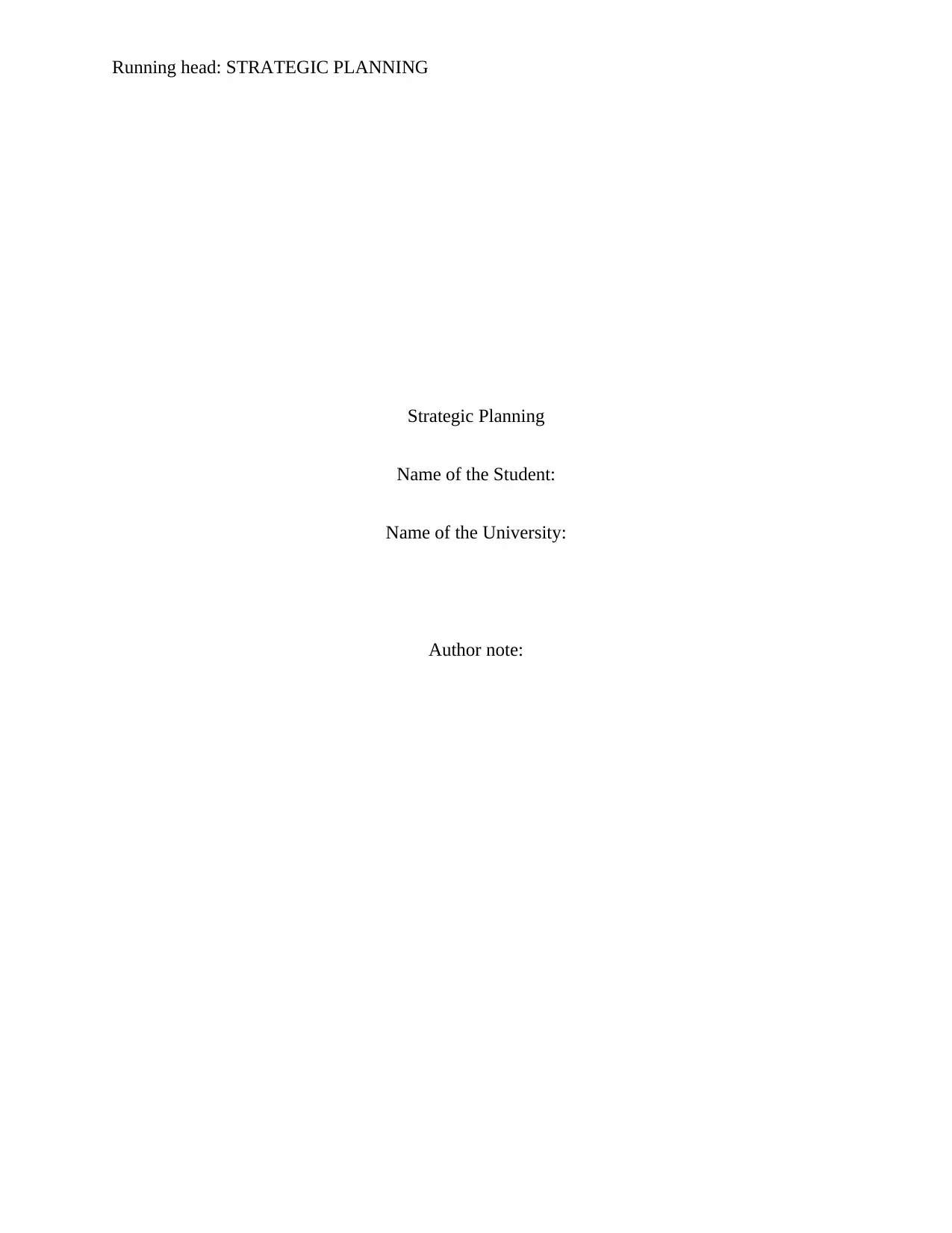
Running head: STRATEGIC PLANNING
Strategic Planning
Name of the Student:
Name of the University:
Author note:
Strategic Planning
Name of the Student:
Name of the University:
Author note:
Paraphrase This Document
Need a fresh take? Get an instant paraphrase of this document with our AI Paraphraser
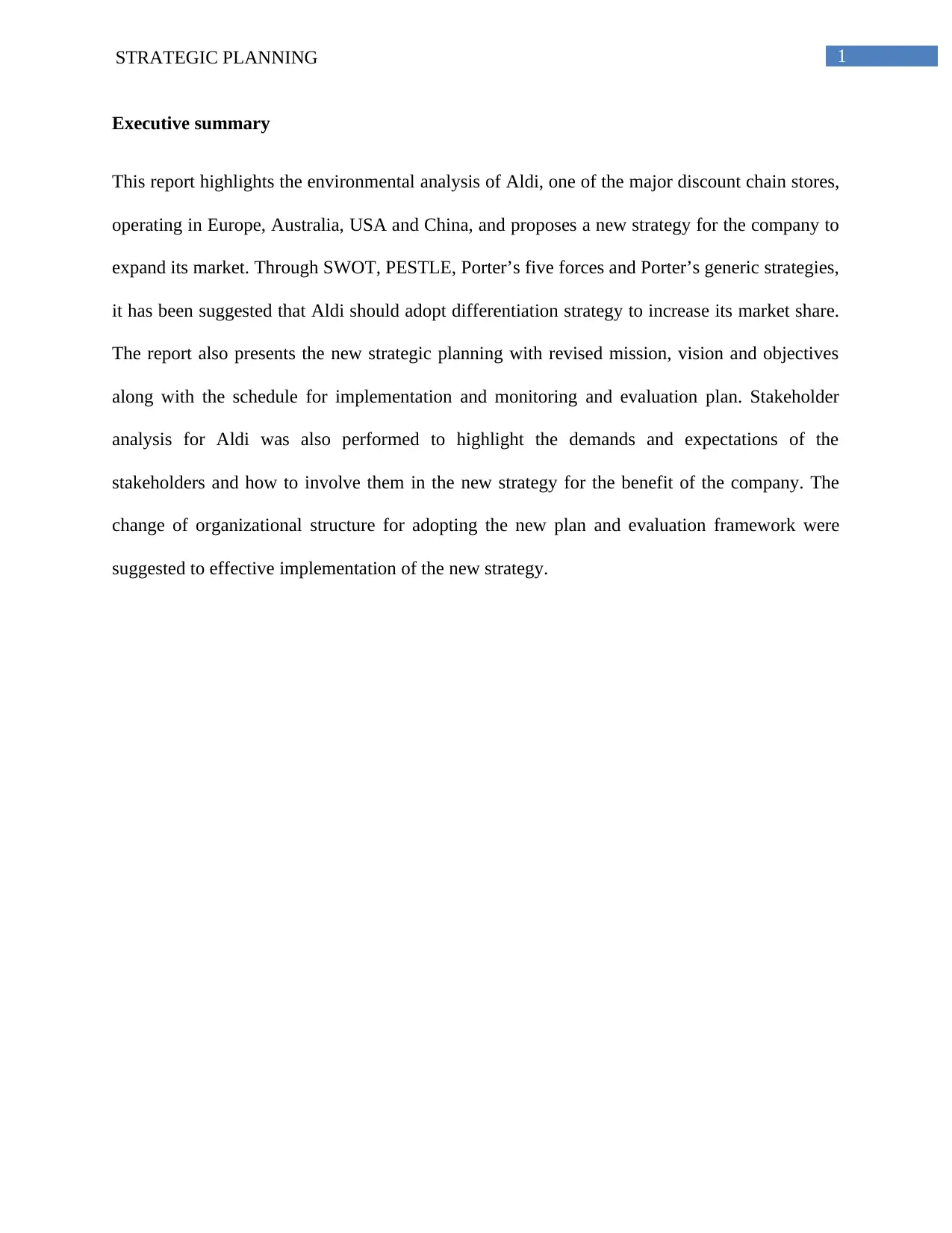
1STRATEGIC PLANNING
Executive summary
This report highlights the environmental analysis of Aldi, one of the major discount chain stores,
operating in Europe, Australia, USA and China, and proposes a new strategy for the company to
expand its market. Through SWOT, PESTLE, Porter’s five forces and Porter’s generic strategies,
it has been suggested that Aldi should adopt differentiation strategy to increase its market share.
The report also presents the new strategic planning with revised mission, vision and objectives
along with the schedule for implementation and monitoring and evaluation plan. Stakeholder
analysis for Aldi was also performed to highlight the demands and expectations of the
stakeholders and how to involve them in the new strategy for the benefit of the company. The
change of organizational structure for adopting the new plan and evaluation framework were
suggested to effective implementation of the new strategy.
Executive summary
This report highlights the environmental analysis of Aldi, one of the major discount chain stores,
operating in Europe, Australia, USA and China, and proposes a new strategy for the company to
expand its market. Through SWOT, PESTLE, Porter’s five forces and Porter’s generic strategies,
it has been suggested that Aldi should adopt differentiation strategy to increase its market share.
The report also presents the new strategic planning with revised mission, vision and objectives
along with the schedule for implementation and monitoring and evaluation plan. Stakeholder
analysis for Aldi was also performed to highlight the demands and expectations of the
stakeholders and how to involve them in the new strategy for the benefit of the company. The
change of organizational structure for adopting the new plan and evaluation framework were
suggested to effective implementation of the new strategy.
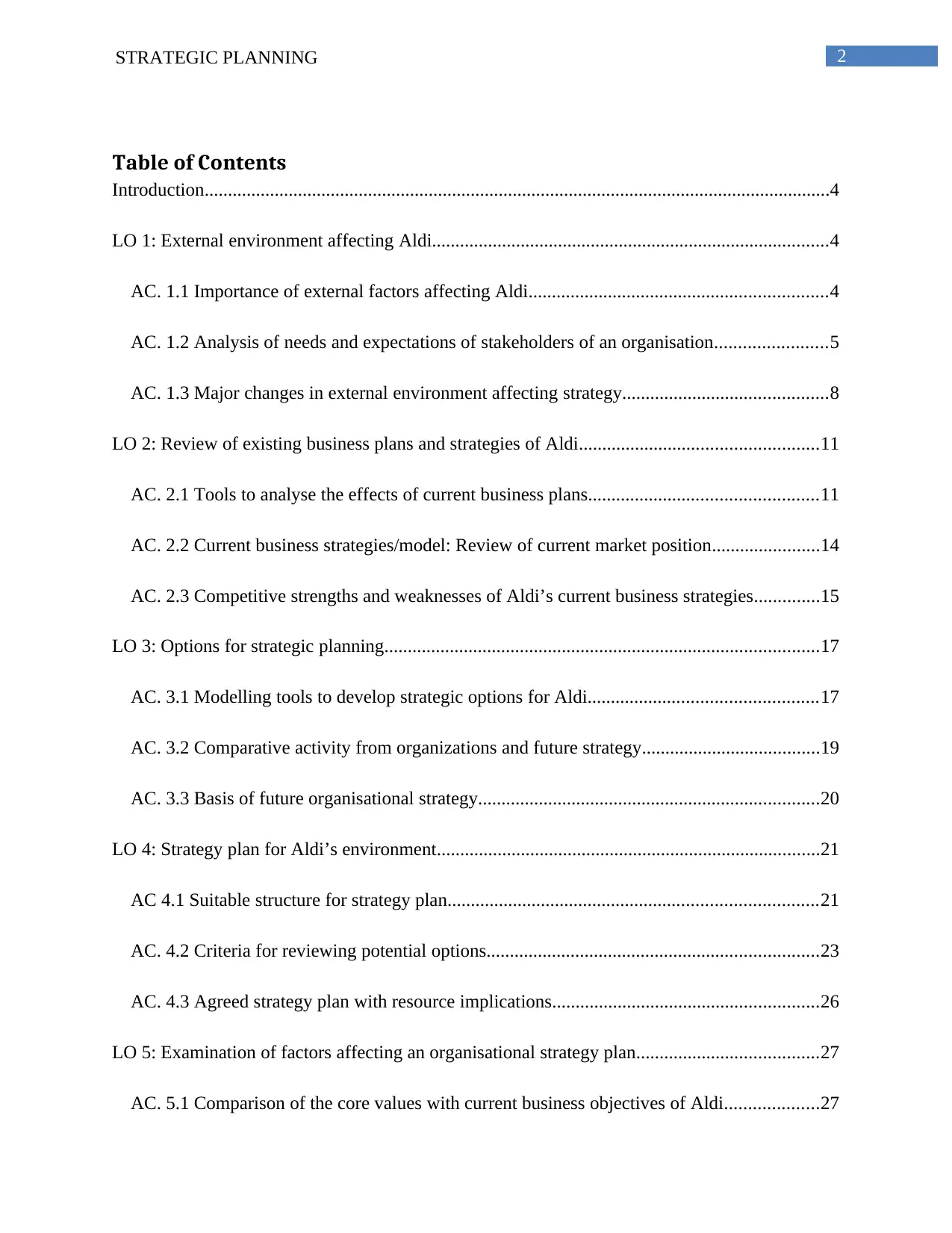
2STRATEGIC PLANNING
Table of Contents
Introduction......................................................................................................................................4
LO 1: External environment affecting Aldi.....................................................................................4
AC. 1.1 Importance of external factors affecting Aldi................................................................4
AC. 1.2 Analysis of needs and expectations of stakeholders of an organisation........................5
AC. 1.3 Major changes in external environment affecting strategy............................................8
LO 2: Review of existing business plans and strategies of Aldi...................................................11
AC. 2.1 Tools to analyse the effects of current business plans.................................................11
AC. 2.2 Current business strategies/model: Review of current market position.......................14
AC. 2.3 Competitive strengths and weaknesses of Aldi’s current business strategies..............15
LO 3: Options for strategic planning.............................................................................................17
AC. 3.1 Modelling tools to develop strategic options for Aldi.................................................17
AC. 3.2 Comparative activity from organizations and future strategy......................................19
AC. 3.3 Basis of future organisational strategy.........................................................................20
LO 4: Strategy plan for Aldi’s environment..................................................................................21
AC 4.1 Suitable structure for strategy plan...............................................................................21
AC. 4.2 Criteria for reviewing potential options.......................................................................23
AC. 4.3 Agreed strategy plan with resource implications.........................................................26
LO 5: Examination of factors affecting an organisational strategy plan.......................................27
AC. 5.1 Comparison of the core values with current business objectives of Aldi....................27
Table of Contents
Introduction......................................................................................................................................4
LO 1: External environment affecting Aldi.....................................................................................4
AC. 1.1 Importance of external factors affecting Aldi................................................................4
AC. 1.2 Analysis of needs and expectations of stakeholders of an organisation........................5
AC. 1.3 Major changes in external environment affecting strategy............................................8
LO 2: Review of existing business plans and strategies of Aldi...................................................11
AC. 2.1 Tools to analyse the effects of current business plans.................................................11
AC. 2.2 Current business strategies/model: Review of current market position.......................14
AC. 2.3 Competitive strengths and weaknesses of Aldi’s current business strategies..............15
LO 3: Options for strategic planning.............................................................................................17
AC. 3.1 Modelling tools to develop strategic options for Aldi.................................................17
AC. 3.2 Comparative activity from organizations and future strategy......................................19
AC. 3.3 Basis of future organisational strategy.........................................................................20
LO 4: Strategy plan for Aldi’s environment..................................................................................21
AC 4.1 Suitable structure for strategy plan...............................................................................21
AC. 4.2 Criteria for reviewing potential options.......................................................................23
AC. 4.3 Agreed strategy plan with resource implications.........................................................26
LO 5: Examination of factors affecting an organisational strategy plan.......................................27
AC. 5.1 Comparison of the core values with current business objectives of Aldi....................27
⊘ This is a preview!⊘
Do you want full access?
Subscribe today to unlock all pages.

Trusted by 1+ million students worldwide
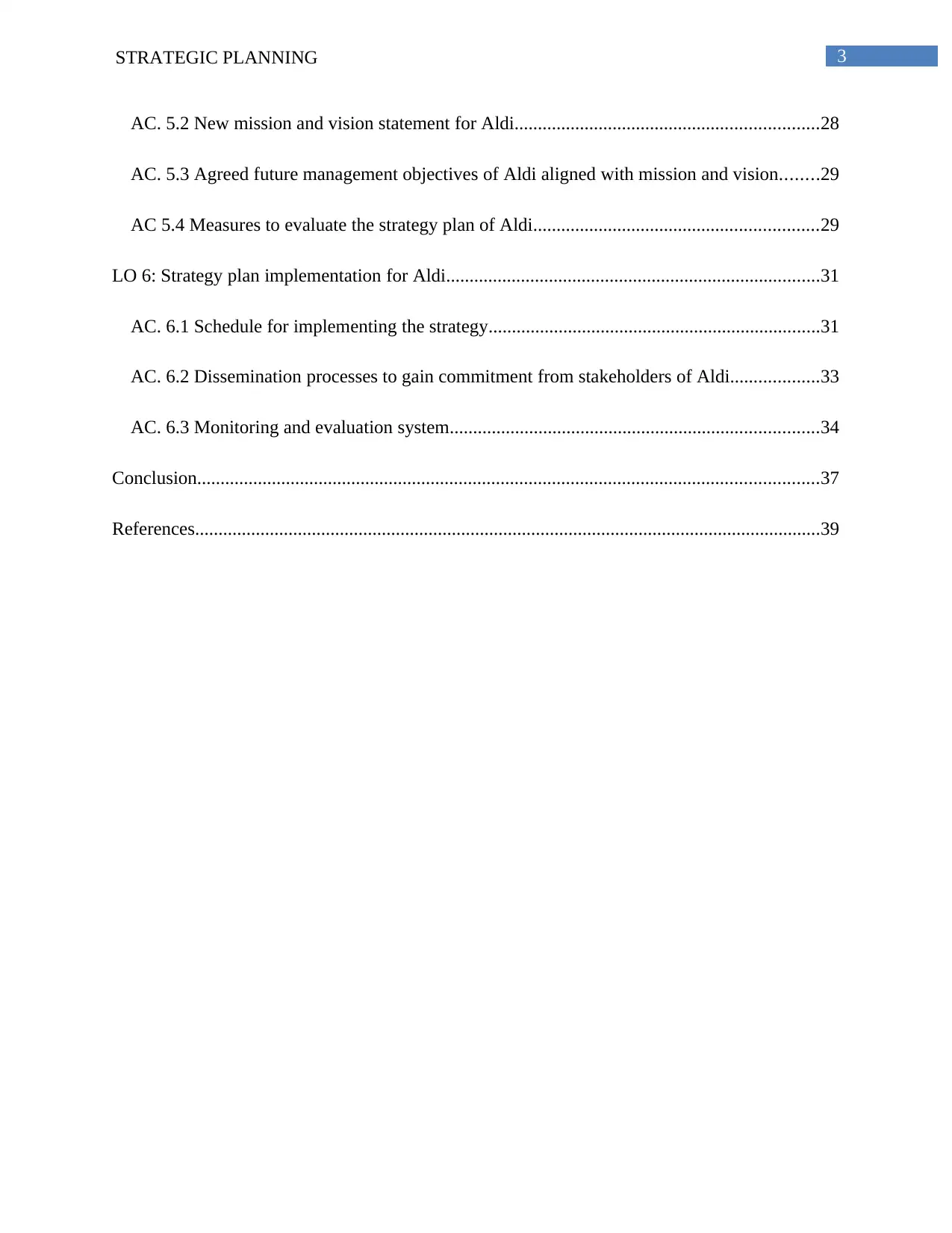
3STRATEGIC PLANNING
AC. 5.2 New mission and vision statement for Aldi.................................................................28
AC. 5.3 Agreed future management objectives of Aldi aligned with mission and vision........29
AC 5.4 Measures to evaluate the strategy plan of Aldi.............................................................29
LO 6: Strategy plan implementation for Aldi................................................................................31
AC. 6.1 Schedule for implementing the strategy.......................................................................31
AC. 6.2 Dissemination processes to gain commitment from stakeholders of Aldi...................33
AC. 6.3 Monitoring and evaluation system...............................................................................34
Conclusion.....................................................................................................................................37
References......................................................................................................................................39
AC. 5.2 New mission and vision statement for Aldi.................................................................28
AC. 5.3 Agreed future management objectives of Aldi aligned with mission and vision........29
AC 5.4 Measures to evaluate the strategy plan of Aldi.............................................................29
LO 6: Strategy plan implementation for Aldi................................................................................31
AC. 6.1 Schedule for implementing the strategy.......................................................................31
AC. 6.2 Dissemination processes to gain commitment from stakeholders of Aldi...................33
AC. 6.3 Monitoring and evaluation system...............................................................................34
Conclusion.....................................................................................................................................37
References......................................................................................................................................39
Paraphrase This Document
Need a fresh take? Get an instant paraphrase of this document with our AI Paraphraser
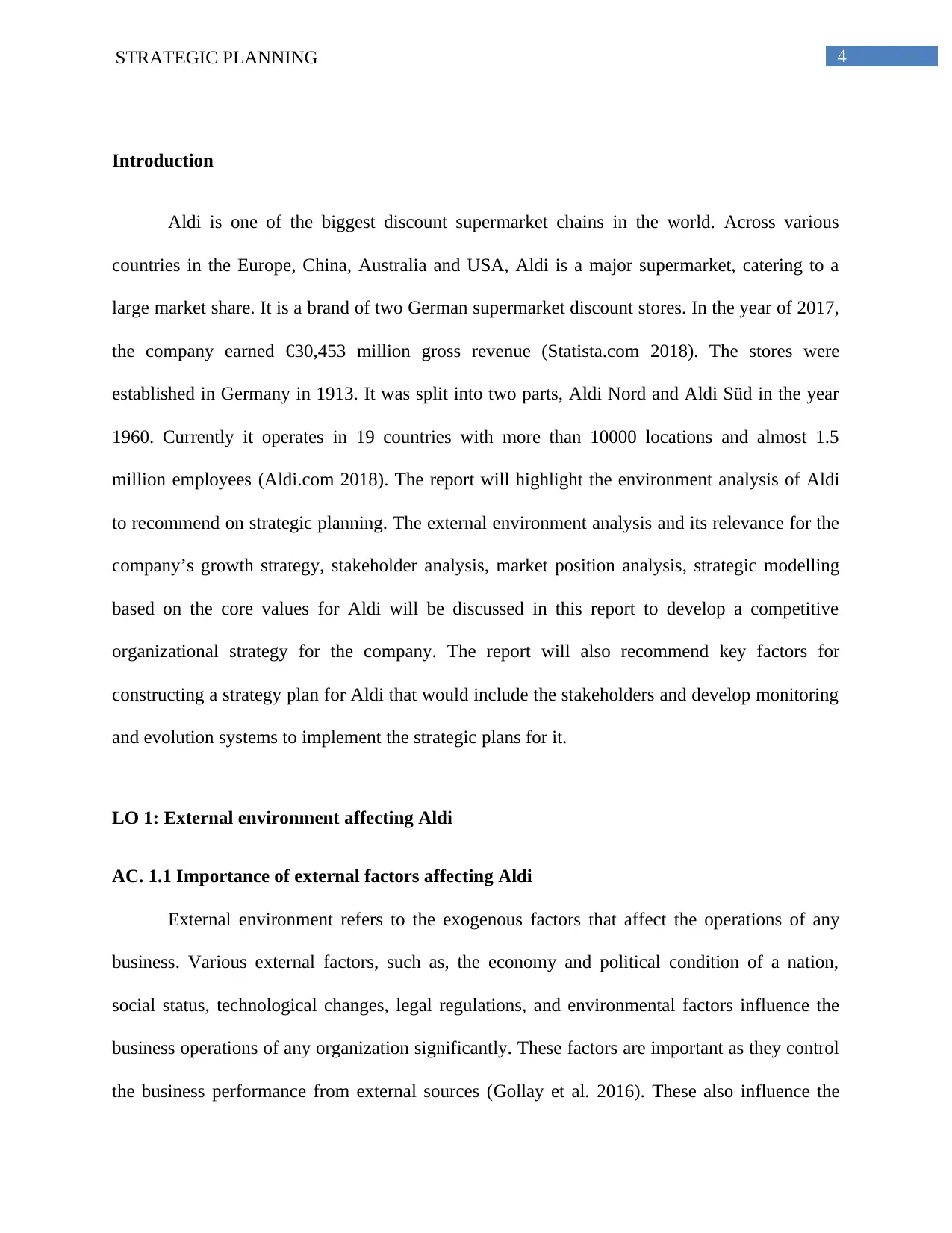
4STRATEGIC PLANNING
Introduction
Aldi is one of the biggest discount supermarket chains in the world. Across various
countries in the Europe, China, Australia and USA, Aldi is a major supermarket, catering to a
large market share. It is a brand of two German supermarket discount stores. In the year of 2017,
the company earned €30,453 million gross revenue (Statista.com 2018). The stores were
established in Germany in 1913. It was split into two parts, Aldi Nord and Aldi Süd in the year
1960. Currently it operates in 19 countries with more than 10000 locations and almost 1.5
million employees (Aldi.com 2018). The report will highlight the environment analysis of Aldi
to recommend on strategic planning. The external environment analysis and its relevance for the
company’s growth strategy, stakeholder analysis, market position analysis, strategic modelling
based on the core values for Aldi will be discussed in this report to develop a competitive
organizational strategy for the company. The report will also recommend key factors for
constructing a strategy plan for Aldi that would include the stakeholders and develop monitoring
and evolution systems to implement the strategic plans for it.
LO 1: External environment affecting Aldi
AC. 1.1 Importance of external factors affecting Aldi
External environment refers to the exogenous factors that affect the operations of any
business. Various external factors, such as, the economy and political condition of a nation,
social status, technological changes, legal regulations, and environmental factors influence the
business operations of any organization significantly. These factors are important as they control
the business performance from external sources (Gollay et al. 2016). These also influence the
Introduction
Aldi is one of the biggest discount supermarket chains in the world. Across various
countries in the Europe, China, Australia and USA, Aldi is a major supermarket, catering to a
large market share. It is a brand of two German supermarket discount stores. In the year of 2017,
the company earned €30,453 million gross revenue (Statista.com 2018). The stores were
established in Germany in 1913. It was split into two parts, Aldi Nord and Aldi Süd in the year
1960. Currently it operates in 19 countries with more than 10000 locations and almost 1.5
million employees (Aldi.com 2018). The report will highlight the environment analysis of Aldi
to recommend on strategic planning. The external environment analysis and its relevance for the
company’s growth strategy, stakeholder analysis, market position analysis, strategic modelling
based on the core values for Aldi will be discussed in this report to develop a competitive
organizational strategy for the company. The report will also recommend key factors for
constructing a strategy plan for Aldi that would include the stakeholders and develop monitoring
and evolution systems to implement the strategic plans for it.
LO 1: External environment affecting Aldi
AC. 1.1 Importance of external factors affecting Aldi
External environment refers to the exogenous factors that affect the operations of any
business. Various external factors, such as, the economy and political condition of a nation,
social status, technological changes, legal regulations, and environmental factors influence the
business operations of any organization significantly. These factors are important as they control
the business performance from external sources (Gollay et al. 2016). These also influence the
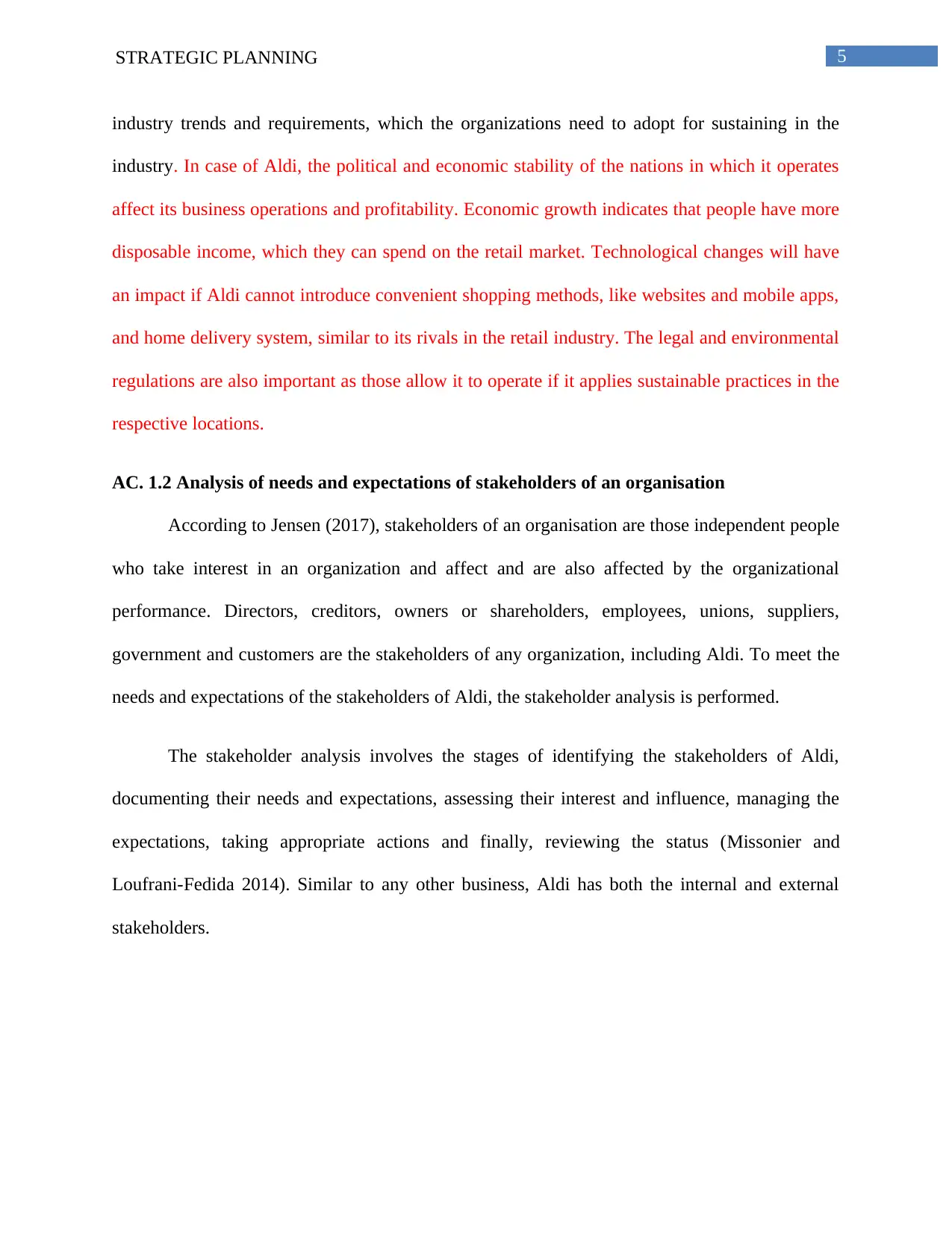
5STRATEGIC PLANNING
industry trends and requirements, which the organizations need to adopt for sustaining in the
industry. In case of Aldi, the political and economic stability of the nations in which it operates
affect its business operations and profitability. Economic growth indicates that people have more
disposable income, which they can spend on the retail market. Technological changes will have
an impact if Aldi cannot introduce convenient shopping methods, like websites and mobile apps,
and home delivery system, similar to its rivals in the retail industry. The legal and environmental
regulations are also important as those allow it to operate if it applies sustainable practices in the
respective locations.
AC. 1.2 Analysis of needs and expectations of stakeholders of an organisation
According to Jensen (2017), stakeholders of an organisation are those independent people
who take interest in an organization and affect and are also affected by the organizational
performance. Directors, creditors, owners or shareholders, employees, unions, suppliers,
government and customers are the stakeholders of any organization, including Aldi. To meet the
needs and expectations of the stakeholders of Aldi, the stakeholder analysis is performed.
The stakeholder analysis involves the stages of identifying the stakeholders of Aldi,
documenting their needs and expectations, assessing their interest and influence, managing the
expectations, taking appropriate actions and finally, reviewing the status (Missonier and
Loufrani-Fedida 2014). Similar to any other business, Aldi has both the internal and external
stakeholders.
industry trends and requirements, which the organizations need to adopt for sustaining in the
industry. In case of Aldi, the political and economic stability of the nations in which it operates
affect its business operations and profitability. Economic growth indicates that people have more
disposable income, which they can spend on the retail market. Technological changes will have
an impact if Aldi cannot introduce convenient shopping methods, like websites and mobile apps,
and home delivery system, similar to its rivals in the retail industry. The legal and environmental
regulations are also important as those allow it to operate if it applies sustainable practices in the
respective locations.
AC. 1.2 Analysis of needs and expectations of stakeholders of an organisation
According to Jensen (2017), stakeholders of an organisation are those independent people
who take interest in an organization and affect and are also affected by the organizational
performance. Directors, creditors, owners or shareholders, employees, unions, suppliers,
government and customers are the stakeholders of any organization, including Aldi. To meet the
needs and expectations of the stakeholders of Aldi, the stakeholder analysis is performed.
The stakeholder analysis involves the stages of identifying the stakeholders of Aldi,
documenting their needs and expectations, assessing their interest and influence, managing the
expectations, taking appropriate actions and finally, reviewing the status (Missonier and
Loufrani-Fedida 2014). Similar to any other business, Aldi has both the internal and external
stakeholders.
⊘ This is a preview!⊘
Do you want full access?
Subscribe today to unlock all pages.

Trusted by 1+ million students worldwide
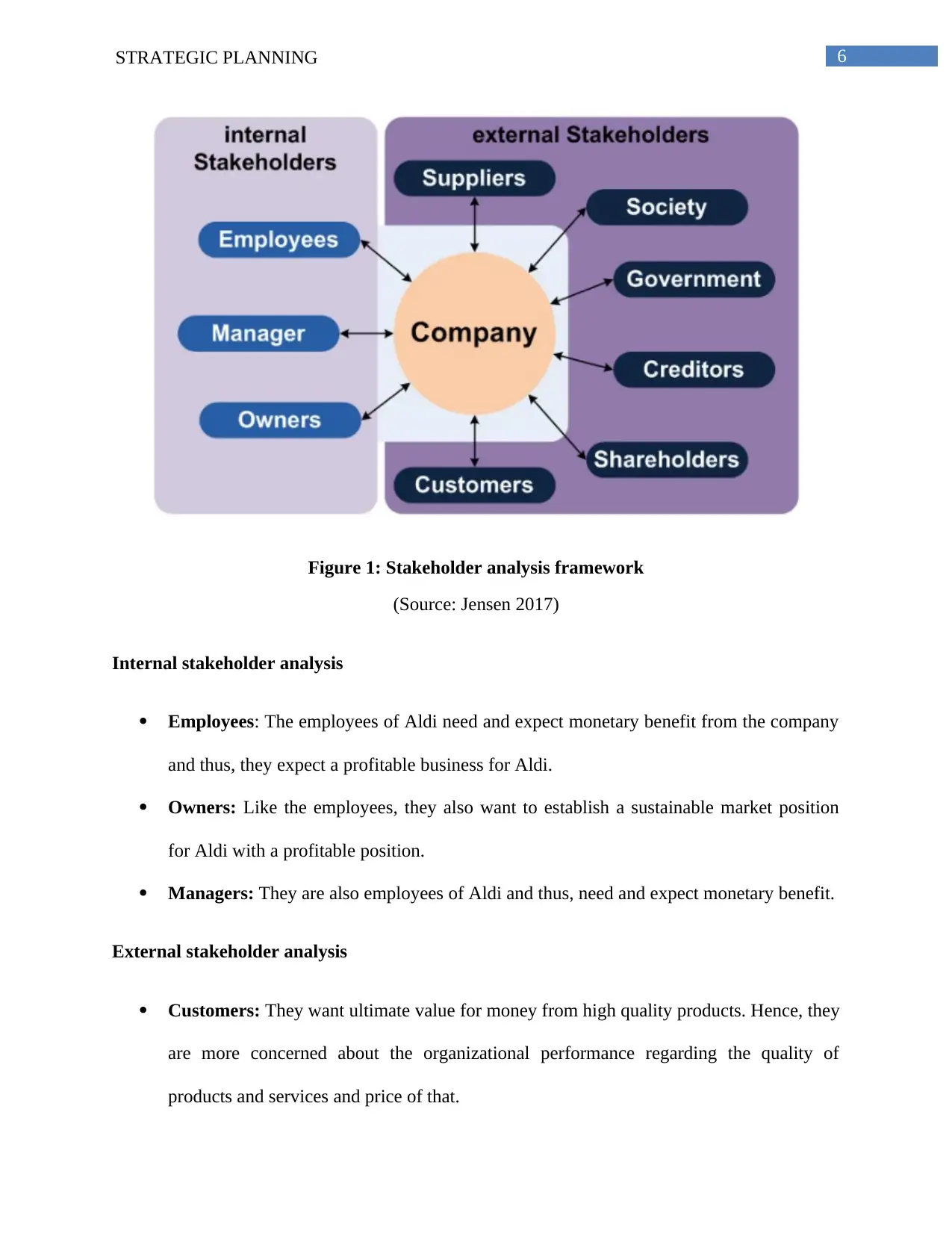
6STRATEGIC PLANNING
Figure 1: Stakeholder analysis framework
(Source: Jensen 2017)
Internal stakeholder analysis
Employees: The employees of Aldi need and expect monetary benefit from the company
and thus, they expect a profitable business for Aldi.
Owners: Like the employees, they also want to establish a sustainable market position
for Aldi with a profitable position.
Managers: They are also employees of Aldi and thus, need and expect monetary benefit.
External stakeholder analysis
Customers: They want ultimate value for money from high quality products. Hence, they
are more concerned about the organizational performance regarding the quality of
products and services and price of that.
Figure 1: Stakeholder analysis framework
(Source: Jensen 2017)
Internal stakeholder analysis
Employees: The employees of Aldi need and expect monetary benefit from the company
and thus, they expect a profitable business for Aldi.
Owners: Like the employees, they also want to establish a sustainable market position
for Aldi with a profitable position.
Managers: They are also employees of Aldi and thus, need and expect monetary benefit.
External stakeholder analysis
Customers: They want ultimate value for money from high quality products. Hence, they
are more concerned about the organizational performance regarding the quality of
products and services and price of that.
Paraphrase This Document
Need a fresh take? Get an instant paraphrase of this document with our AI Paraphraser
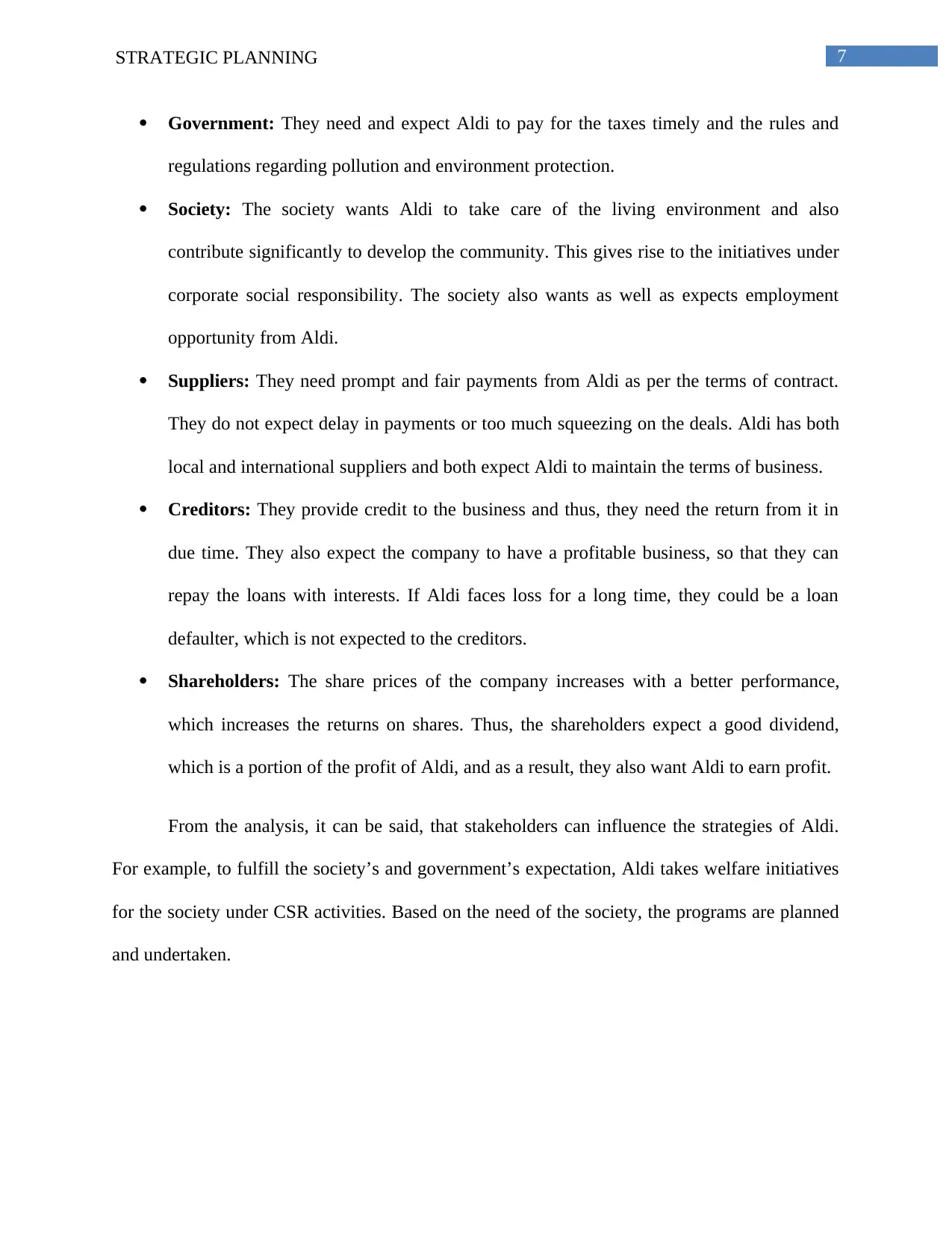
7STRATEGIC PLANNING
Government: They need and expect Aldi to pay for the taxes timely and the rules and
regulations regarding pollution and environment protection.
Society: The society wants Aldi to take care of the living environment and also
contribute significantly to develop the community. This gives rise to the initiatives under
corporate social responsibility. The society also wants as well as expects employment
opportunity from Aldi.
Suppliers: They need prompt and fair payments from Aldi as per the terms of contract.
They do not expect delay in payments or too much squeezing on the deals. Aldi has both
local and international suppliers and both expect Aldi to maintain the terms of business.
Creditors: They provide credit to the business and thus, they need the return from it in
due time. They also expect the company to have a profitable business, so that they can
repay the loans with interests. If Aldi faces loss for a long time, they could be a loan
defaulter, which is not expected to the creditors.
Shareholders: The share prices of the company increases with a better performance,
which increases the returns on shares. Thus, the shareholders expect a good dividend,
which is a portion of the profit of Aldi, and as a result, they also want Aldi to earn profit.
From the analysis, it can be said, that stakeholders can influence the strategies of Aldi.
For example, to fulfill the society’s and government’s expectation, Aldi takes welfare initiatives
for the society under CSR activities. Based on the need of the society, the programs are planned
and undertaken.
Government: They need and expect Aldi to pay for the taxes timely and the rules and
regulations regarding pollution and environment protection.
Society: The society wants Aldi to take care of the living environment and also
contribute significantly to develop the community. This gives rise to the initiatives under
corporate social responsibility. The society also wants as well as expects employment
opportunity from Aldi.
Suppliers: They need prompt and fair payments from Aldi as per the terms of contract.
They do not expect delay in payments or too much squeezing on the deals. Aldi has both
local and international suppliers and both expect Aldi to maintain the terms of business.
Creditors: They provide credit to the business and thus, they need the return from it in
due time. They also expect the company to have a profitable business, so that they can
repay the loans with interests. If Aldi faces loss for a long time, they could be a loan
defaulter, which is not expected to the creditors.
Shareholders: The share prices of the company increases with a better performance,
which increases the returns on shares. Thus, the shareholders expect a good dividend,
which is a portion of the profit of Aldi, and as a result, they also want Aldi to earn profit.
From the analysis, it can be said, that stakeholders can influence the strategies of Aldi.
For example, to fulfill the society’s and government’s expectation, Aldi takes welfare initiatives
for the society under CSR activities. Based on the need of the society, the programs are planned
and undertaken.
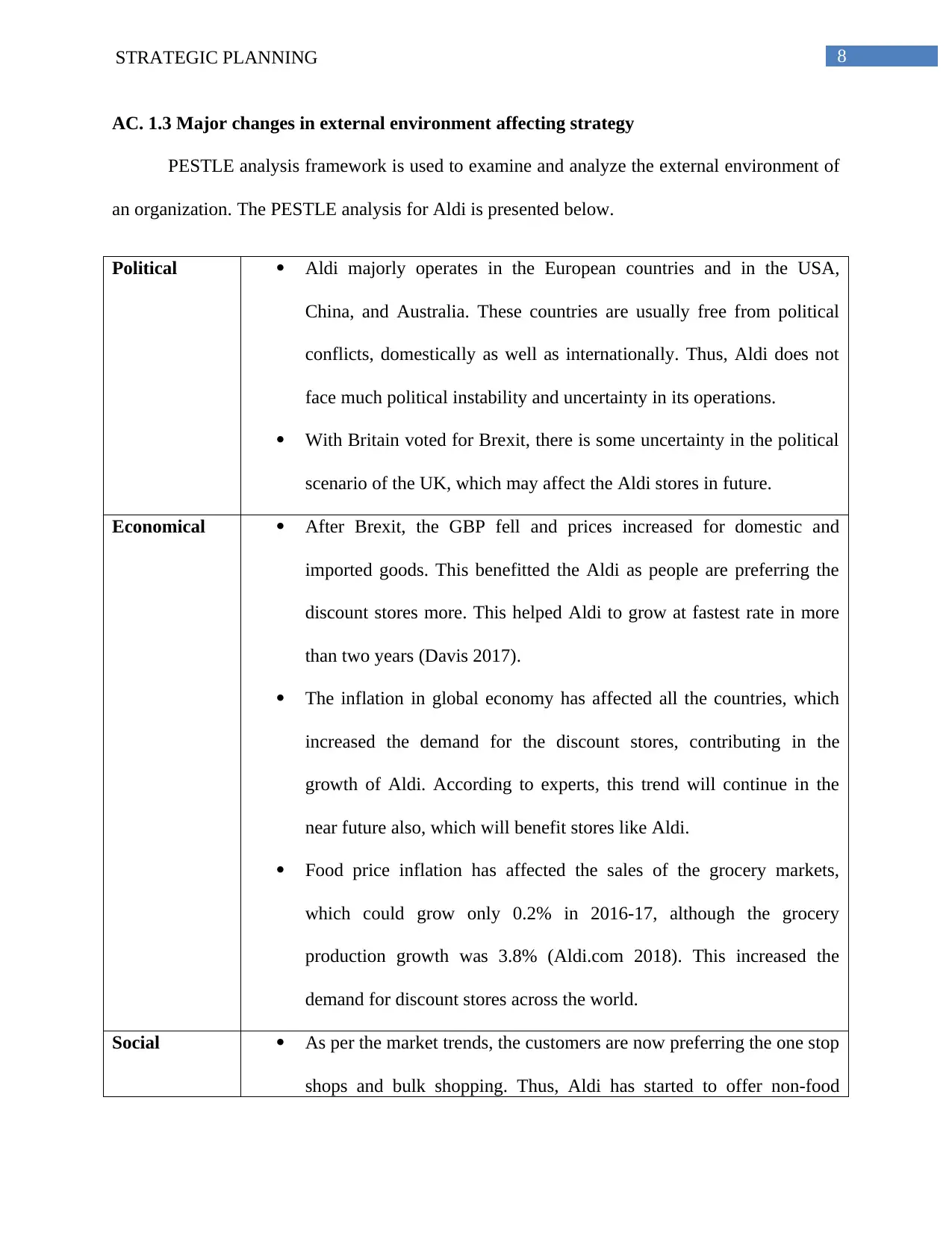
8STRATEGIC PLANNING
AC. 1.3 Major changes in external environment affecting strategy
PESTLE analysis framework is used to examine and analyze the external environment of
an organization. The PESTLE analysis for Aldi is presented below.
Political Aldi majorly operates in the European countries and in the USA,
China, and Australia. These countries are usually free from political
conflicts, domestically as well as internationally. Thus, Aldi does not
face much political instability and uncertainty in its operations.
With Britain voted for Brexit, there is some uncertainty in the political
scenario of the UK, which may affect the Aldi stores in future.
Economical After Brexit, the GBP fell and prices increased for domestic and
imported goods. This benefitted the Aldi as people are preferring the
discount stores more. This helped Aldi to grow at fastest rate in more
than two years (Davis 2017).
The inflation in global economy has affected all the countries, which
increased the demand for the discount stores, contributing in the
growth of Aldi. According to experts, this trend will continue in the
near future also, which will benefit stores like Aldi.
Food price inflation has affected the sales of the grocery markets,
which could grow only 0.2% in 2016-17, although the grocery
production growth was 3.8% (Aldi.com 2018). This increased the
demand for discount stores across the world.
Social As per the market trends, the customers are now preferring the one stop
shops and bulk shopping. Thus, Aldi has started to offer non-food
AC. 1.3 Major changes in external environment affecting strategy
PESTLE analysis framework is used to examine and analyze the external environment of
an organization. The PESTLE analysis for Aldi is presented below.
Political Aldi majorly operates in the European countries and in the USA,
China, and Australia. These countries are usually free from political
conflicts, domestically as well as internationally. Thus, Aldi does not
face much political instability and uncertainty in its operations.
With Britain voted for Brexit, there is some uncertainty in the political
scenario of the UK, which may affect the Aldi stores in future.
Economical After Brexit, the GBP fell and prices increased for domestic and
imported goods. This benefitted the Aldi as people are preferring the
discount stores more. This helped Aldi to grow at fastest rate in more
than two years (Davis 2017).
The inflation in global economy has affected all the countries, which
increased the demand for the discount stores, contributing in the
growth of Aldi. According to experts, this trend will continue in the
near future also, which will benefit stores like Aldi.
Food price inflation has affected the sales of the grocery markets,
which could grow only 0.2% in 2016-17, although the grocery
production growth was 3.8% (Aldi.com 2018). This increased the
demand for discount stores across the world.
Social As per the market trends, the customers are now preferring the one stop
shops and bulk shopping. Thus, Aldi has started to offer non-food
⊘ This is a preview!⊘
Do you want full access?
Subscribe today to unlock all pages.

Trusted by 1+ million students worldwide

9STRATEGIC PLANNING
items also.
Demographic changes, such as, rise in female workers, and aging
population and decline in the home cooked food and risisng demand
for organic food have contributed in bringing changes in the type of
product offerings of the discount stores.
Technological Supermarkets have been introducing self-checkout systems to
minimize the effort by the employees as well as saving the time of the
customers, who wants a faster checkout for a few items (Orel and Kara
2014).
The supermarkets are also developing mobile apps, which allow easy
shopping for the customers along with home delivery of the products.
Introduction of technology for Efficient Consumer Response (ECR)
system and Radio Frequency Identification (RFID) system by the other
discount stores, which are still not adopted by Aldi.
Legal In all the locations, Aldi has followed the country specific legislations
regarding the business and licenses.
The countries also have regulations regarding health benefits of the
citizens and thus, impose various types of restrictions on deliverable
food items, which need to be followed strictly.
Environmenta
l
Sustainability of the local produce is a major challenge for the
supermarkets and discount grocery stores.
Regulations regarding mismanagement of resources and exhaustive
cultivation in each operating countries are becoming quite strict to
items also.
Demographic changes, such as, rise in female workers, and aging
population and decline in the home cooked food and risisng demand
for organic food have contributed in bringing changes in the type of
product offerings of the discount stores.
Technological Supermarkets have been introducing self-checkout systems to
minimize the effort by the employees as well as saving the time of the
customers, who wants a faster checkout for a few items (Orel and Kara
2014).
The supermarkets are also developing mobile apps, which allow easy
shopping for the customers along with home delivery of the products.
Introduction of technology for Efficient Consumer Response (ECR)
system and Radio Frequency Identification (RFID) system by the other
discount stores, which are still not adopted by Aldi.
Legal In all the locations, Aldi has followed the country specific legislations
regarding the business and licenses.
The countries also have regulations regarding health benefits of the
citizens and thus, impose various types of restrictions on deliverable
food items, which need to be followed strictly.
Environmenta
l
Sustainability of the local produce is a major challenge for the
supermarkets and discount grocery stores.
Regulations regarding mismanagement of resources and exhaustive
cultivation in each operating countries are becoming quite strict to
Paraphrase This Document
Need a fresh take? Get an instant paraphrase of this document with our AI Paraphraser
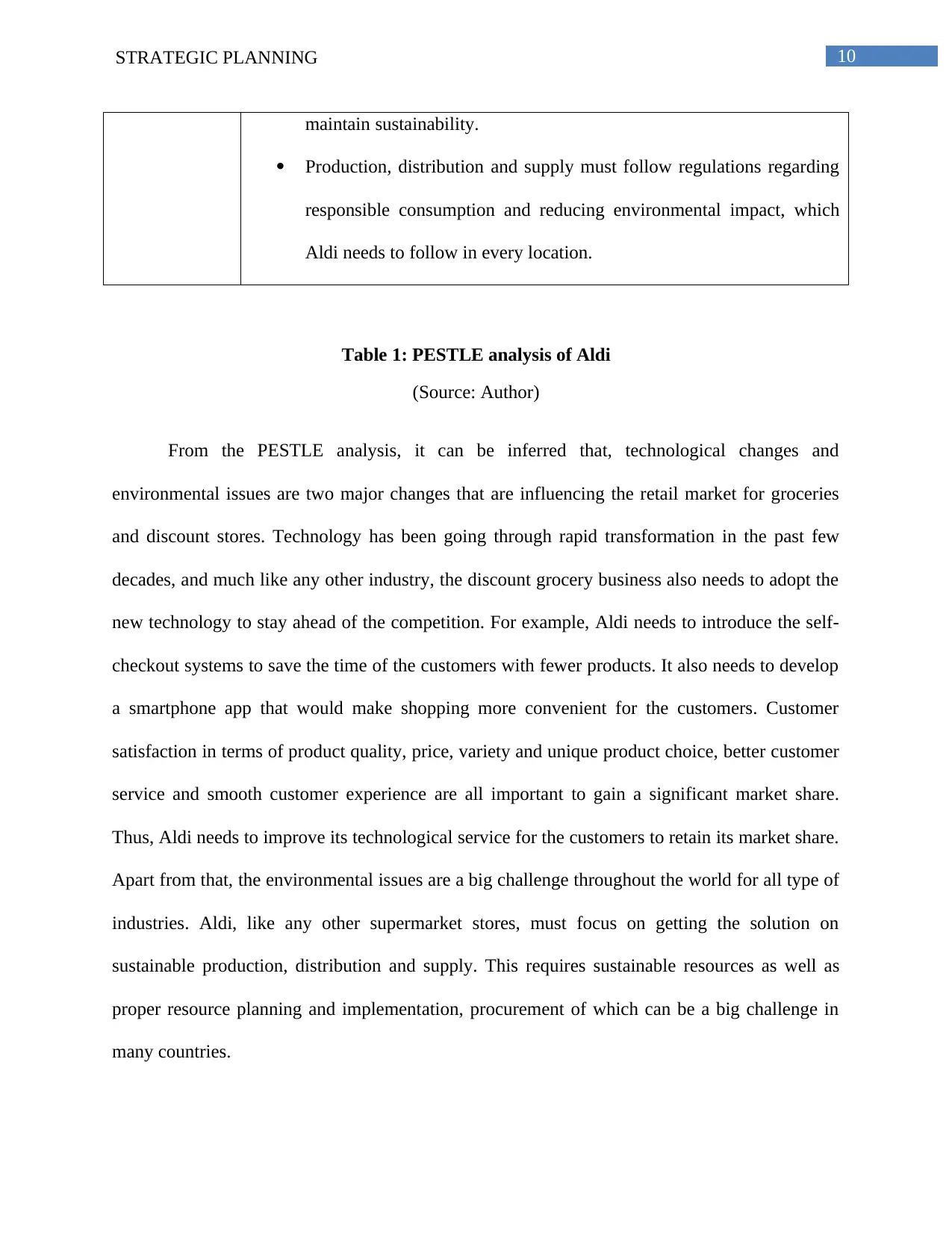
10STRATEGIC PLANNING
maintain sustainability.
Production, distribution and supply must follow regulations regarding
responsible consumption and reducing environmental impact, which
Aldi needs to follow in every location.
Table 1: PESTLE analysis of Aldi
(Source: Author)
From the PESTLE analysis, it can be inferred that, technological changes and
environmental issues are two major changes that are influencing the retail market for groceries
and discount stores. Technology has been going through rapid transformation in the past few
decades, and much like any other industry, the discount grocery business also needs to adopt the
new technology to stay ahead of the competition. For example, Aldi needs to introduce the self-
checkout systems to save the time of the customers with fewer products. It also needs to develop
a smartphone app that would make shopping more convenient for the customers. Customer
satisfaction in terms of product quality, price, variety and unique product choice, better customer
service and smooth customer experience are all important to gain a significant market share.
Thus, Aldi needs to improve its technological service for the customers to retain its market share.
Apart from that, the environmental issues are a big challenge throughout the world for all type of
industries. Aldi, like any other supermarket stores, must focus on getting the solution on
sustainable production, distribution and supply. This requires sustainable resources as well as
proper resource planning and implementation, procurement of which can be a big challenge in
many countries.
maintain sustainability.
Production, distribution and supply must follow regulations regarding
responsible consumption and reducing environmental impact, which
Aldi needs to follow in every location.
Table 1: PESTLE analysis of Aldi
(Source: Author)
From the PESTLE analysis, it can be inferred that, technological changes and
environmental issues are two major changes that are influencing the retail market for groceries
and discount stores. Technology has been going through rapid transformation in the past few
decades, and much like any other industry, the discount grocery business also needs to adopt the
new technology to stay ahead of the competition. For example, Aldi needs to introduce the self-
checkout systems to save the time of the customers with fewer products. It also needs to develop
a smartphone app that would make shopping more convenient for the customers. Customer
satisfaction in terms of product quality, price, variety and unique product choice, better customer
service and smooth customer experience are all important to gain a significant market share.
Thus, Aldi needs to improve its technological service for the customers to retain its market share.
Apart from that, the environmental issues are a big challenge throughout the world for all type of
industries. Aldi, like any other supermarket stores, must focus on getting the solution on
sustainable production, distribution and supply. This requires sustainable resources as well as
proper resource planning and implementation, procurement of which can be a big challenge in
many countries.
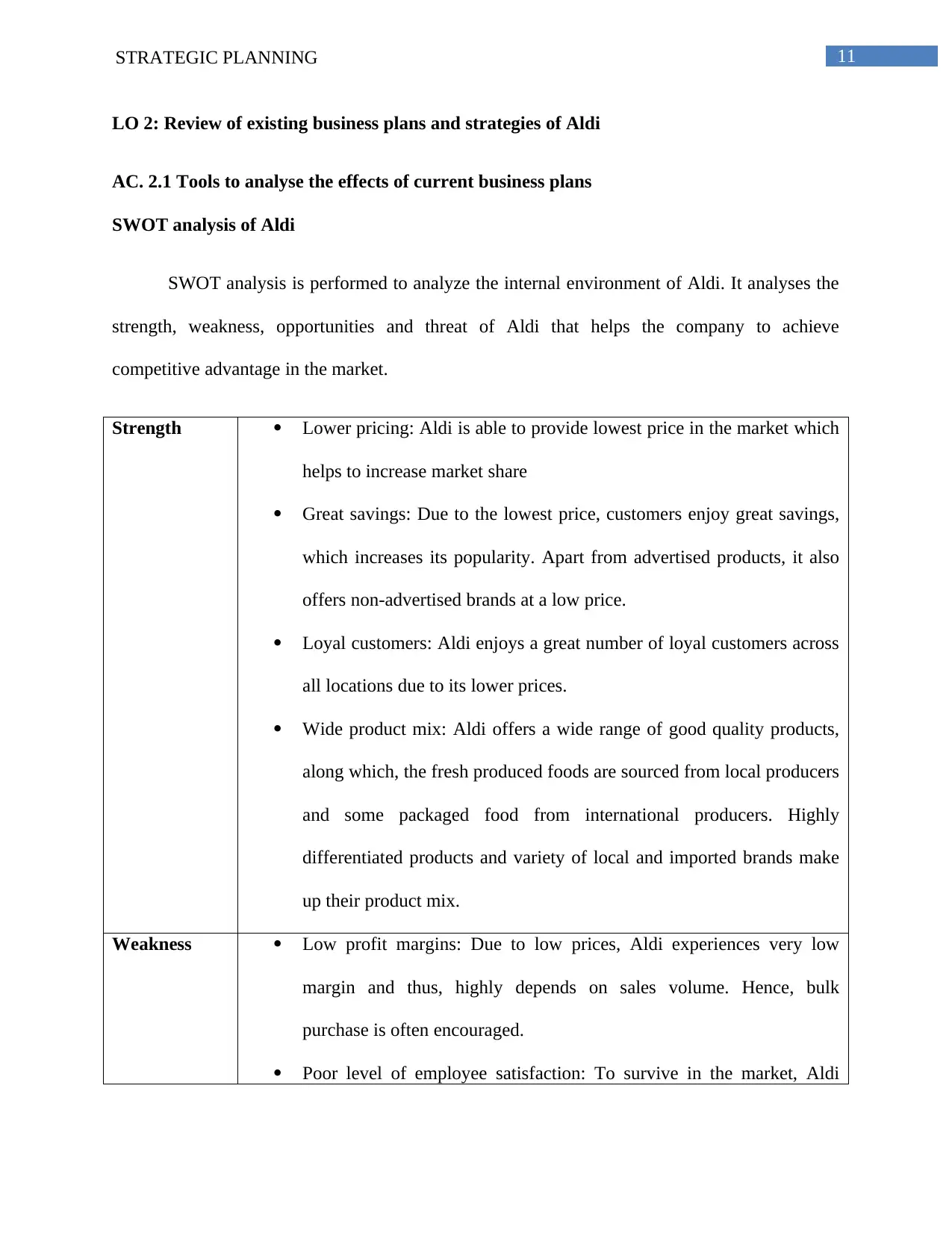
11STRATEGIC PLANNING
LO 2: Review of existing business plans and strategies of Aldi
AC. 2.1 Tools to analyse the effects of current business plans
SWOT analysis of Aldi
SWOT analysis is performed to analyze the internal environment of Aldi. It analyses the
strength, weakness, opportunities and threat of Aldi that helps the company to achieve
competitive advantage in the market.
Strength Lower pricing: Aldi is able to provide lowest price in the market which
helps to increase market share
Great savings: Due to the lowest price, customers enjoy great savings,
which increases its popularity. Apart from advertised products, it also
offers non-advertised brands at a low price.
Loyal customers: Aldi enjoys a great number of loyal customers across
all locations due to its lower prices.
Wide product mix: Aldi offers a wide range of good quality products,
along which, the fresh produced foods are sourced from local producers
and some packaged food from international producers. Highly
differentiated products and variety of local and imported brands make
up their product mix.
Weakness Low profit margins: Due to low prices, Aldi experiences very low
margin and thus, highly depends on sales volume. Hence, bulk
purchase is often encouraged.
Poor level of employee satisfaction: To survive in the market, Aldi
LO 2: Review of existing business plans and strategies of Aldi
AC. 2.1 Tools to analyse the effects of current business plans
SWOT analysis of Aldi
SWOT analysis is performed to analyze the internal environment of Aldi. It analyses the
strength, weakness, opportunities and threat of Aldi that helps the company to achieve
competitive advantage in the market.
Strength Lower pricing: Aldi is able to provide lowest price in the market which
helps to increase market share
Great savings: Due to the lowest price, customers enjoy great savings,
which increases its popularity. Apart from advertised products, it also
offers non-advertised brands at a low price.
Loyal customers: Aldi enjoys a great number of loyal customers across
all locations due to its lower prices.
Wide product mix: Aldi offers a wide range of good quality products,
along which, the fresh produced foods are sourced from local producers
and some packaged food from international producers. Highly
differentiated products and variety of local and imported brands make
up their product mix.
Weakness Low profit margins: Due to low prices, Aldi experiences very low
margin and thus, highly depends on sales volume. Hence, bulk
purchase is often encouraged.
Poor level of employee satisfaction: To survive in the market, Aldi
⊘ This is a preview!⊘
Do you want full access?
Subscribe today to unlock all pages.

Trusted by 1+ million students worldwide
1 out of 41
Related Documents
Your All-in-One AI-Powered Toolkit for Academic Success.
+13062052269
info@desklib.com
Available 24*7 on WhatsApp / Email
![[object Object]](/_next/static/media/star-bottom.7253800d.svg)
Unlock your academic potential
Copyright © 2020–2025 A2Z Services. All Rights Reserved. Developed and managed by ZUCOL.





